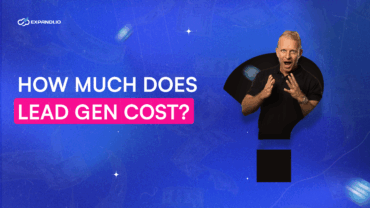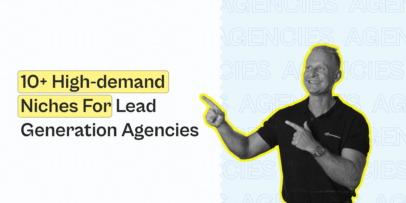9 Critical Metrics That Each Lead Gen Agency Should Track
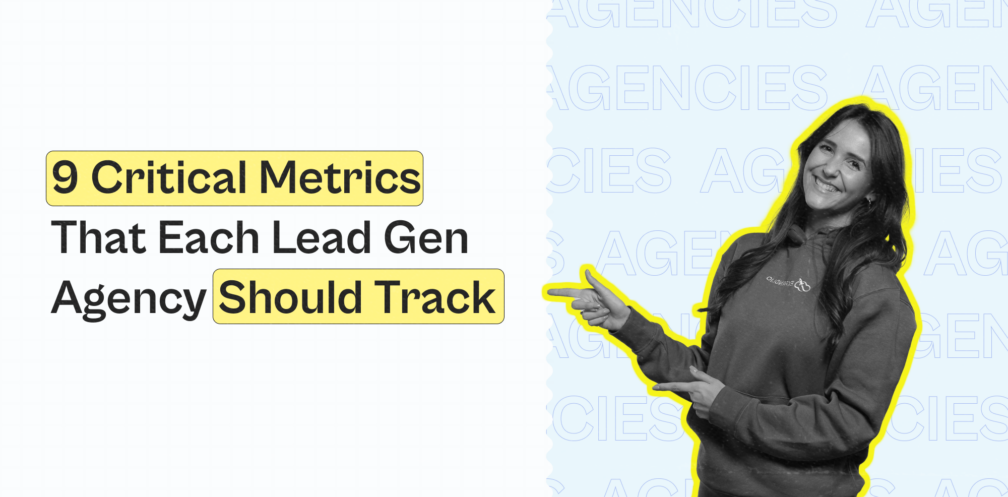
There’s so much noise and data surrounding your lead generation efforts that measuring what matters feels like an impossible challenge.
On top of this, 91% of B2B businesses say lead generation is their most important goal.
So, considering this fierce competition, measuring the right lead generation metrics, knowing where you stand, and what to improve is the ultimate road to success.
Don’t worry, we got you. This simplified guide covers the top 9 lead gen agency metrics for success.
Why are good analytics so crucial for lead generation agencies’ success?
Picture this:
Lead generation agency A measures KPIs like open rate, reply rate, and email-to-meeting-booked ratio each month. It uses these analytics to tweak its content and outreach personalization whenever it notices a drop in performance.
Meanwhile, lead generation agency B does not continuously measure its KPIs. Instead, it sticks to a generic outreach approach due to a lack of insight into customer engagement and eventually notices customer churn.
In simple terms, good analytics and the right metrics help a lead generation agency to:
- Understand if the outreach methods and content are relevant to the prospect or customer
- Analyze if the offer is good enough
- Understand what campaigns performed well and what didn’t in a specific timeframe
- Understand customer engagement dynamics
- Know where to invest resources for the best ROI
- And more!
We’re going to divide lead gen metrics into two categories:
- Campaign performance metrics
- Agency growth metrics
Campaign performance metrics
Measuring campaign performance helps teams prove the effectiveness of their email, LinkedIn, messaging, and other campaigns against several business goals.
Timely measurements of these metrics support making improvements wherever necessary so that your future campaigns provide better ROI.
The following are the 6 lead generation campaign performance metrics to measure campaign effectiveness:
1. Email open rate
What it is:
A good email open rate tells you how good your subject line, the opening hook, and timings are. They also hint at whether your email deliverability is above average or if it needs a spam check.
Why it’s important:
Measuring open rates is especially vital if you’re running cold email campaigns.
The better your email deliverability and the more catchy and effective your email subject line, the higher the open rates and the closer you are to receiving more responses.
Always aim to have an open rate of 65%+.
How to measure it:
The open rate can be calculated using this formula:
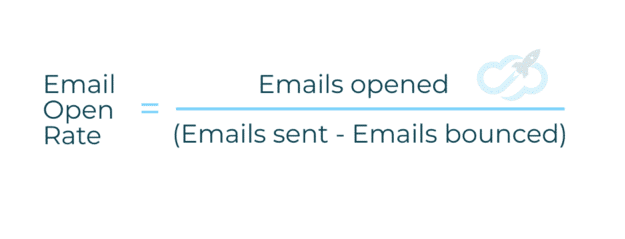
2. Email reply rate
What it is:
A reply rate is the percentage of recipients who’ve opened and responded to your email.
Why it’s important:
While open rates indicate your subject and opening lines are great, a good reply rate can indicate:
- The percentage of recipients responding to your email
- If the offer is relevant to the recipient
- If the rest of the email performed well
- If the CTA was specific enough to stir replies
A higher open rate and a weak reply rate are still bad news. It means you must improve the copy by researching your ICP and tailoring the offer. The best way to fix this is to A/B test your email outreach campaigns using different versions of the subject line, opening hook, triggers, and CTA.
How to measure it:
The email reply rate can be calculated using this formula:

3. LinkedIn connection request acceptance rate
What it is:
You know B2B lead generation efforts are incomplete without LinkedIn outreach. Tracking the LinkedIn connection request acceptance rate will tell you if you’re reaching the right ICP or not and often leads accept your connection requests.
Why it’s important:
A good LinkedIn connection request acceptance rate shows you’re putting in the right effort in researching your ICP and personalizing the connection requests. A bad rate could indicate you’re reaching the wrong people or are sending a generic opening hook.
How to measure it:
The LinkedIn connection request acceptance rate can be calculated using this formula:
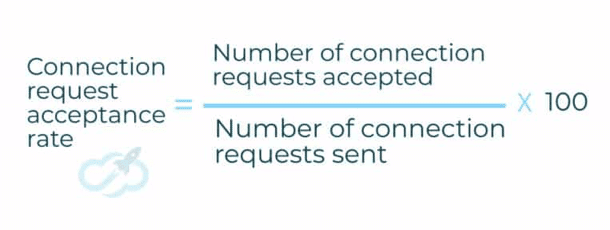
4. LinkedIn message reply rate (after connection request acceptance)
What it is:
Your prospect accepted your LinkedIn connection request. Now what? You send them a usual LinkedIn message as a follow-up to build rapport or to communicate the next steps. So, measuring their responses to this message gives you the LinkedIn message reply rate.
Why it’s important:
A strong LinkedIn message reply rate indicates prospects are high-intent leads worth pursuing and that your messaging is relevant.
A bad reply rate may indicate you’re not personalizing the messages enough or need to rework your targeting strategy.
How to measure it:
Your LinkedIn reply rate can be measured using the following formula:

5. Email/connection-to-meeting ratio
What it is:
The email/connection-to-meeting ratio tells you the number of emails/LinkedIn connection messages you must send to secure one meeting with the prospect. So, the smaller the ratio, the better. In simpler terms – the quality of emails/messages matters over the quantity.
Although this ratio can differ from industry to industry, the average lead gen agency could be sending around 600 emails/messages to successfully book one meeting.
Whatever the average may be, always strive to reduce your ratio to 1:400 or lower.
Why it’s important:
Figuring out your email/meeting-to-meeting ratio can help you:
- Understand what email/LinkedIn outreach campaigns perform well or poorly
- Predict results. For example, if your monthly quota is to book 15 meetings, then you’ll need to contact 7500 each month (considering your ratio to be 1:500).
- Know how much capital to allocate and what your sales team must do to hit the monthly quota
How to measure it:
Measure the email/connection-to-meeting ratio using this formula:

6. Stage conversion rate
What it is:
The stage conversion rate is a pipeline conversion KPI that states the percentage of prospects moving from one stage to the next in a typical sales pipeline.
For example, Leads reached out to (300) > Leads replied (20) – a 6% conversion rate > Discovery calls booked (10) a 50% conversion rate > Product demos booked (7) a 70% conversion rate > Deals closed (3) a 40% conversion rate.
A low conversion rate noticed between any of these stages indicates something must be fixed.
Why it’s important:
Measuring the conversion rate at every stage of your sales pipeline can pinpoint the biggest drop-offs and help you optimize those stages.
In the previous example, we see a lower conversion rate from “Leads reached out to” to “Leads replied” (just over 6%). This clearly points out the need to re-establish a personalized outreach strategy.
How to measure it:
To measure the stage conversion rate at each stage:
(Leads who moved on to the previous stage / Number of leads in the previous stage) x 100
Agency growth metrics
Is your agency progressing in the right direction? Are your targets meeting your revenue goals and budget? Growth-oriented agency metrics can give you answers.
Agency growth metrics help agency owners and business managers make strategic business decisions and give insights into the agency’s profitability.
The following are the 3 must-track lead gen agency growth metrics:
1. Client acquisition cost (CAC)
What it is:
The CAC tells you how much you spend acquiring a new customer. It could be the total cost of your sales and marketing efforts, tools, training programs, and more.
Why it’s important:
Measuring CAC helps improve your sales and marketing efforts without going overboard with your budget. It uncovers any potential sales funnel inefficiencies where your team may be spending too many unnecessary resources.
How to measure it:
CAC can be calculated using the below formula:
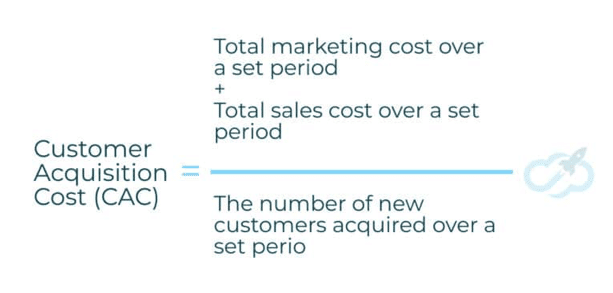
2. Client lifetime value (CLV)
What it is:
The client or customer lifetime value (CLV) is a prediction of the amount a client may spend on your products or services during the course of their business relationship with you.
Why it’s important:
CLV is a vital metric for lead generation agencies because:
- It looks beyond a single sale and gives a full picture of a customer’s true value
- A customer with low CLV can indicate you don’t have to spend too much effort or resources on them
- CLV helps you target high-value customer segments
- Measuring CLV lets you optimize lead generation efforts, such as tailoring marketing messages to attract high-value customers
How to measure it:
CLV can be calculated using the below formula:
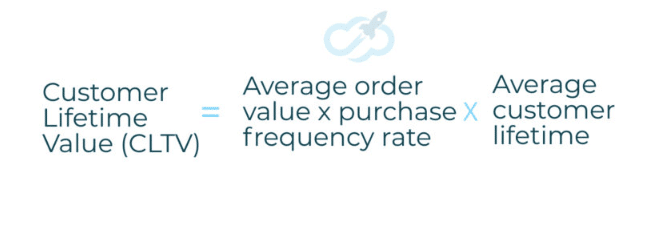
3. Client acquisition timeline (CAT)
What it is:
The client acquisition timeline can be used to measure the time it takes for your sales and marketing teams to get customers on board. It measures the time it takes from a prospect first engaging with your business to becoming a paying client.
Why it’s important:
CAT gives you an insight into how well your sales funnel performs and what to fix to shorten the timeline for acquiring new clients. For example, a lead generation agency measuring CAT may identify that their sales reps spend too much time explaining product features and thus help them with fresh resources like presentations.
How to measure it:
The client acquisition timeline can be measured using the following formula:
(Conversion date – Initial contact date) / Total number of leads generated
Wrapping up – running a successful business by the numbers
Numbers, or in our words, metrics, give you every piece of evidence on how well or badly your business performs.
For lead generation agencies, metrics are all the more important to predict revenue, keep guesswork at bay, and boost outreach efforts.
Start by adding a powerful outreach tool like Expandi to your tool stack. Expandi’s dashboard offers real-time updates on outreach numbers—all from one place.
Make measuring your outreach efforts seamless with Expandi – grab the 7-day free trial today!
You’ve made it all the way down here, take the final step
